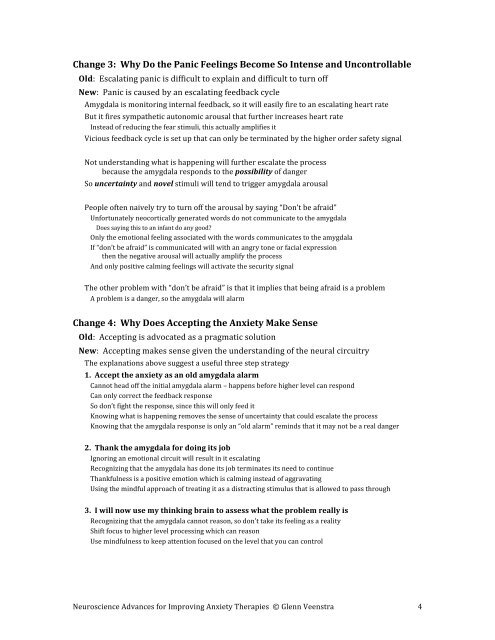Veenstra 170 - Anxiety Disorders Association of America
Veenstra 170 - Anxiety Disorders Association of America
Veenstra 170 - Anxiety Disorders Association of America
Create successful ePaper yourself
Turn your PDF publications into a flip-book with our unique Google optimized e-Paper software.
Change 3: Why Do the Panic Feelings Become So Intense and Uncontrollable<br />
Old: Escalating panic is difficult to explain and difficult to turn <strong>of</strong>f<br />
New: Panic is caused by an escalating feedback cycle<br />
Amygdala is monitoring internal feedback, so it will easily fire to an escalating heart rate<br />
But it fires sympathetic autonomic arousal that further increases heart rate<br />
Instead <strong>of</strong> reducing the fear stimuli, this actually amplifies it<br />
Vicious feedback cycle is set up that can only be terminated by the higher order safety signal<br />
Not understanding what is happening will further escalate the process<br />
because the amygdala responds to the possibility <strong>of</strong> danger<br />
So uncertainty and novel stimuli will tend to trigger amygdala arousal<br />
People <strong>of</strong>ten naively try to turn <strong>of</strong>f the arousal by saying “Don’t be afraid”<br />
Unfortunately neocortically generated words do not communicate to the amygdala<br />
Does saying this to an infant do any good?<br />
Only the emotional feeling associated with the words communicates to the amygdala<br />
If “don’t be afraid” is communicated will with an angry tone or facial expression<br />
then the negative arousal will actually amplify the process<br />
And only positive calming feelings will activate the security signal<br />
The other problem with “don’t be afraid” is that it implies that being afraid is a problem<br />
A problem is a danger, so the amygdala will alarm<br />
Change 4: Why Does Accepting the <strong>Anxiety</strong> Make Sense<br />
Old: Accepting is advocated as a pragmatic solution<br />
New: Accepting makes sense given the understanding <strong>of</strong> the neural circuitry<br />
The explanations above suggest a useful three step strategy<br />
1. Accept the anxiety as an old amygdala alarm<br />
Cannot head <strong>of</strong>f the initial amygdala alarm – happens before higher level can respond<br />
Can only correct the feedback response<br />
So don’t fight the response, since this will only feed it<br />
Knowing what is happening removes the sense <strong>of</strong> uncertainty that could escalate the process<br />
Knowing that the amygdala response is only an “old alarm” reminds that it may not be a real danger<br />
2. Thank the amygdala for doing its job<br />
Ignoring an emotional circuit will result in it escalating<br />
Recognizing that the amygdala has done its job terminates its need to continue<br />
Thankfulness is a positive emotion which is calming instead <strong>of</strong> aggravating<br />
Using the mindful approach <strong>of</strong> treating it as a distracting stimulus that is allowed to pass through<br />
3. I will now use my thinking brain to assess what the problem really is<br />
Recognizing that the amygdala cannot reason, so don’t take its feeling as a reality<br />
Shift focus to higher level processing which can reason<br />
Use mindfulness to keep attention focused on the level that you can control<br />
Neuroscience Advances for Improving <strong>Anxiety</strong> Therapies © Glenn <strong>Veenstra</strong> 4


